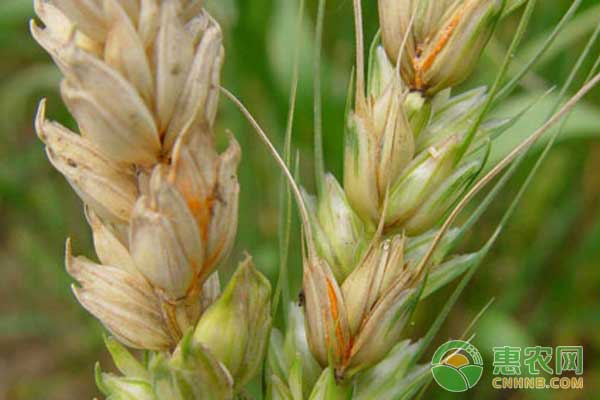In the near future, strong cooling weather will be introduced, and heavy snow or heavy snow will be ushered in the north or northeast, while the central and eastern regions will cool down. Farmers planting winter wheat should not apply herbicides in the wheat field for nearly two days. In particular, the early buckwheat in Huaibei and the wheat fields that have emerged in the past, do not apply systemic herbicides in the past few days before the cooling. In addition to isoproterone, methyl disulfuron, two more dangerous drugs, clodinafop, oxazolin, benzoxazole, benzosulfuron, bensulfuron, flufensulfuron, Do not use acesulfame, flupiroxime or flufenacetate. Today, I will talk about the prevention and control of pests and diseases in wheat. Farmers’ friends must have the idea of ​​“prevention first, comprehensive preventionâ€. The problem of pests and diseases for wheat is summarized as follows: Wheat scab Wheat saplings, flowering period, selective osmotic, rain-resistant scouring, long-lasting compounding agents for rust and powdery mildew, such as cyanide, tebuconazole, oxazolone, tebuconazole, C Oxazole · tebuconazole, pentazole, prochloraz, benzoic acid, ethiazole, thiazolone, jinggang · wax bud, methyl thio- tebuconazole, pentazole carbendazim, imipenem Mixin, fluorocyclohexane, carbendazim, carbendazim, carbendazim, etc., or choose a single dose of cymene ester mixed with tebuconazole to prevent water spray; if the flowering period is rainy or foggy, it should be 5 after medicine Around the day, the spraying will be carried out once again, and the third prevention and control will be carried out in the later stages depending on the climate change. Wheat sheath blight It is mainly used for the prevention of seed dressing in autumn sowing period; the application of pesticide control in the late stage of wheat to the early stage of jointing, the control index is 10%. Mu with active ingredient Jinggang·Bacillus (jinggangmycin 4%, Bacillus cereus 1.6 billion/g) 26 g, or benzoylpropanazole 9 g, or diniconazole 7.5 g, or Jinggangmycin A10 grams, or 10 grams of propiconazole. When applying dew in the morning, apply the medicine and increase the water consumption so that the liquid can flow to the base of the wheat plant. The heavily ill field (region) is prevented once again about 10 days after application. In case of flooding, clear the ditch and drain water in time to reduce the humidity in the field and create environmental conditions that are not conducive to the disease. Wheat rust, powdery mildew When the wheat stripe rust disease is found in the field, the diseased leaves should be removed immediately to the field for burning or deep burial; for the early occurrence of the disease center, it is necessary to immediately prevent and control the spread. The leaf rate of field rust disease is 0.5%, the leaf rate of leaf rust disease is 10%, and the leaf rate of powdery mildew disease is 15%. 8 grams of the active ingredient diniconazole, or 10 grams of propiconazole, or 4 grams of myclobutanil, or 9 grams of ether fungus ester, or 7.5 grams of epoxiconazole can be used for spray control. The seriously ill field was again prevented for 7-10 days after the first spraying. Wheat aphid Pay attention to the protection and use of natural enemies, and focus on protecting the natural enemies such as the seven-spotted ladybug, the worm-like ladybug, and the scorpion bee. When the ratio of the number of enemy units to the number of locusts is greater than 1:322, it can effectively control the damage of wheat stalks, and it is not necessary to apply pesticides to control wheat stalks. When the amount of wheat stubble in the field exceeds the control index (300 seedlings per 100 seedlings, 500 heads/hundred earings), and the number of natural enemies is below the utilization index, 5 grams of the active ingredient pymetrozine, or acetamiprid 2 Gram, or flinamide nitrile 1-1.5 grams, or thiamethoxam 2-2.5 grams, against water spray control, and treatment of wheat field gray planthopper. When the amount of spikes in the late stage is large, it is possible to use high-chlorofluorothiazem, biphenyl-thiachlor, and high-chlorine acetamiprid for prevention and treatment. Wheat red spider In the autumn seedling period, 50 heads per foot (or 75 wheat per square foot in the wheat field), and 200 wheat fields per market length (or 350 wheat per square foot in the wheat field), immediately Spray control. The active ingredient is bifenthrin 1.2-2 g, or avermectin 0.2-0.4 g. In view of the small number of registered drugs for controlling wheat red spiders, other crop-registered acaricides may also be used in production. Overall control technology Efforts should be made to grasp the overall prevention and control of pests and diseases in the sowing period of wheat, from the time of greening to the beginning of jointing and the stage of flowering and flowering. In the early stage of wheat jointing, the main target of sheath blight is to treat both pests such as wheat spiders and nurseries. When wheat is found in the flowering stage, the overall control is carried out by scab, and the rust, powdery mildew, leaf blight and bud are treated according to local conditions. Blight, gray planthopper, armyworm, etc. The above is the key prevention and control technology for winter wheat pests and diseases. In addition to the pest control measures in the winter, the growers must also take antifreeze measures! Salty Beans,Round Black Bean Salted,Salted Black Bean Round,Salted Soy Beans jiangmen city hongsing food co., ltd. , https://www.jmhongsing.com
